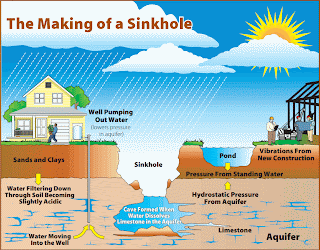 |
| Click for large view |
Lara Miller,
Natural Resources Agent
You’ve heard it in the news and you’ve seen it in your neighborhood, sinkholes are happening, but why? Underneath your home, garden or business is a layer of Karst topography or landscape. This Karst topography is made up of limestone rock which is composed of a mineral called calcite. Calcite is a mineral developed from fossilized remains of sea creatures that died and sank to the ocean floor 25 to 60 million years ago. Over these millions of years, shell remains became compacted into layers of whitish rock we know as limestone.
Karst topography is the reason Florida has sinkholes, springs, disappearing streams and even caves. Rainfall that percolates or seeps through the soil absorbs carbon dioxide and reacts with decaying vegetation along the way which leads to water that is slightly acidic. This acidified water slowly dissolves limestone rock as it moves through spaces and cracks underground, creating a network of cavities or holes. These holes serve as a sink for more acidic water, leading to larger cracks and voids over time. Sinkholes form when the underlying layer of limestone rock can no longer support the overlying elements (sediments, houses, etc.) and the earth collapses into the cavity.
Do sinkholes happen naturally or are humans contributing to these events?
Natural factors can contribute to ideal conditions for sinkholes to form. For example, a heavy rain following a long period of drought can cause enough overlying pressure in certain areas to cause the earth to cave in. Higher levels of pumping or removal of groundwater can also contribute to the formation of a sinkhole, especially during long periods of time with little to no rain.
Aside from the obvious damage sinkholes can cause, are there any other concerns?
Sinkholes may contribute to water quality problems if rainwater is not filtered by the soil and plants before reaching the aquifer, our underground source of drinking water. In an ideal scenario, rainwater will be caught by the leaves, branches and bark of trees and vegetation before it hits the ground. These obstacles slow the momentum of rainwater allowing it to seep into the soil to be filtered by the natural system before entering the aquifer. In the case of a sinkhole, rainwater flowing into the cavity may reach our aquifer without being filtered and result in reduced water quality.
Resources and additional information:
http://www.swfwmd.state.fl.us/hydrology/sinkholes/brochure.pdf
http://edis.ifas.ufl.edu/dh399
 0
0
